Nsg 120 unit 2 exam Study guides, Class notes & Summaries
Looking for the best study guides, study notes and summaries about Nsg 120 unit 2 exam? On this page you'll find 45 study documents about Nsg 120 unit 2 exam.
Page 4 out of 45 results
Sort by

-
BSN NSG 3068/NSG 3068 Fundamentals of nursing exam -1 Review 2020
- Other • 24 pages • 2021
-
- $10.49
- + learn more
BSN NSG 3068/NSG 3068 Fundamentals of nursing exam -1 Review Frequently measured vital signs include Temperature Pulse Respiration Blood pressure Oxygen saturation considered as 5 th vital sign Pain considered as 6 th vital sign. Pain is subjective. When are vital signs taken? Admission to hospital, facility, office visit (baseline) Monitor patient condition Identify problems Evaluate response during intervention (before, after, during). Temperature: Temperature rang...
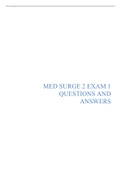
-
NSG 330 MedSurg 2 Exam 1 Corrected
- Exam (elaborations) • 7 pages • 2022
-
- $15.99
- + learn more
NSG 330: Med-Surge II Exam #1 Question 1: A nurse assesses an older adult client who is experiencing a myocardial infarction. Which clinical manifestation should the nurse expect? Selected Answer: d. Disorientation and confusion Response Feedback: In older adults, disorientation or confusion may be the major manifestation of myocardial infarction caused by poor cardiac output. Pain manifestations and numbness and tingling of the arm could also be related to the myocardial infarction. How...
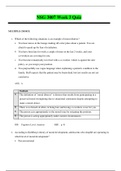
-
NSG 3007 Week 3 Quiz / NSG3007 Week 3 Quiz (Latest-2020): Foundations of Professional Nursing: South University |100% Correct Answers, Download to Score A|
- Exam (elaborations) • 67 pages • 2020
- Available in package deal
-
- $8.49
- 2x sold
- + learn more
NSG 3007 Week 3 Quiz MULTIPLE CHOICE 1. Which of the following situations is an example of moral distress? a. You hear nurses in the lounge making off-color jokes about a patient. You are afraid to speak up for fear of retaliation. b. You have been late for work a couple of times in the last 2 weeks, and your co-workers are covering for you. c. You become romantically involved with a co-worker, which is against the unit policy, so you resign your position. d. You purposefully use vague langua...
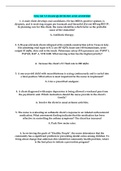
-
NSG 321 V3 EXAM QUESTIONS AND ANSWERS
- Exam (elaborations) • 21 pages • 2022
-
- $14.49
- + learn more
NSG 321 V3 EXAM QUESTIONS AND ANSWERS 1. A male client develops oral candidiasis. He has MRSA-positive sputum, is dyspneic, and is receiving oxygen per facemask and linezolid (Zyvox) 600 mg BID IV. In planning care for this client, the nurse identifies which factor as the probable cause of the stomatitis? A. Antibiotic therapy. 2. A 38-year-old male client collapsed at his outside construction job in Texas in July. His admitting vital signs to ICU are: BP 82/70, heart rate 140 beats/m...
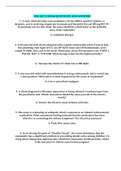
-
NSG 321 V3 EXAM QUESTIONS AND ANSWERS
- Exam (elaborations) • 21 pages • 2022
-
- $14.49
- + learn more
NSG 321 V3 EXAM QUESTIONS AND ANSWERS 1. A male client develops oral candidiasis. He has MRSA-positive sputum, is dyspneic, and is receiving oxygen per facemask and linezolid (Zyvox) 600 mg BID IV. In planning care for this client, the nurse identifies which factor as the probable cause of the stomatitis? A. Antibiotic therapy. 2. A 38-year-old male client collapsed at his outside construction job in Texas in July. His admitting vital signs to ICU are: BP 82/70, heart rate 140 beats/m...
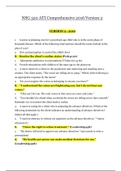
-
NSG 320 ATI Comprehensive 2016 Version 2 | NSG320 ATI Comprehensive 2016 Version 2 {A GRADE}
- Exam (elaborations) • 40 pages • 2021
-
- $22.99
- + learn more
NSG 320 ATI Comprehensive 2016 Version 2 VERSION 2 - 2016 1. A nurse is planning care for a preschool-age child who is in the acute phase of Kawasaki disease. Which of the following interventions should the nurse include in the plan of care? a. Give acetaminophen to control the child’s fever B. Monitor the client’s cardiac status (Peds p120) c. Administer antibiotics via intermittent IV bolus for 24 hrs d. Provide stimulation with children of...
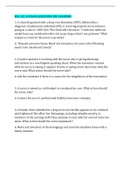
-
NSG 321 V4 EXAM QUESTIONS AND ANSWERS
- Exam (elaborations) • 21 pages • 2022
-
- $14.49
- + learn more
NSG 321 V4 EXAM QUESTIONS AND ANSWERS 1. A client diagnosed with a deep vein thrombus (DVT), followed by a diagnosis of pulmonary embolism (PE), is receiving heparin via an infusion pump at a rate of 1400 U/hr. The client tells the nurse, “I wish this medicine would hurry up and dissolve this clot in my lung so that I can go home.” What response is best for the nurse to provide? A. “Heparin prevents future blood clot formation, but your risk of bleeding needs to be monitored cl...
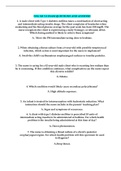
-
NSG 321 V2 EXAM QUESTIONS AND ANSWERS
- Exam (elaborations) • 23 pages • 2022
-
- $14.49
- + learn more
NSG 321 V2 EXAM QUESTIONS AND ANSWERS 1. A male client with Type 1 diabetes mellitus takes a combination of short-acting and intermediate-acting insulin drugs. The client complains of headaches when awakening and his blood glucose average for the past week has been 210 mg/dl. The nurse recognizes the client is experiencing a daily Somogyi, or rebound, effect. Which dosing method is likely to relieve these symptoms? A. Move the PM intermediate-acting dose to bedtime. 2. When obtaining ...
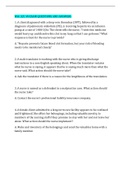
-
NSG 321 V4 EXAM QUESTIONS AND ANSWERS
- Exam (elaborations) • 21 pages • 2022
-
- $14.00
- + learn more
NSG 321 V4 EXAM QUESTIONS AND ANSWERSA client diagnosed with a deep vein thrombus (DVT), followed by a diagnosis of pulmonary embolism (PE), is receiving heparin via an infusion pump at a rate of 1400 U/hr. The client tells the nurse, “I wish this medicine would hurry up and dissolve this clot in my lung so that I can go home.” What response is best for the nurse to provide? A. “Heparin prevents future blood clot formation, but your risk of bleeding needs to be monitored closely...
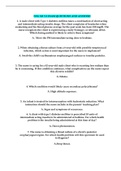
-
NSG 321 V2 EXAM QUESTIONS AND ANSWERS
- Exam (elaborations) • 23 pages • 2022
-
- $14.49
- + learn more
NSG 321 V2 EXAM QUESTIONS AND ANSWERS 1. A male client with Type 1 diabetes mellitus takes a combination of short-acting and intermediate-acting insulin drugs. The client complains of headaches when awakening and his blood glucose average for the past week has been 210 mg/dl. The nurse recognizes the client is experiencing a daily Somogyi, or rebound, effect. Which dosing method is likely to relieve these symptoms? A. Move the PM intermediate-acting dose to bedtime. 2. When obtaining ...

How much did you already spend on Stuvia? Imagine there are plenty more of you out there paying for study notes, but this time YOU are the seller. Ka-ching! Discover all about earning on Stuvia


